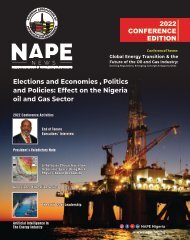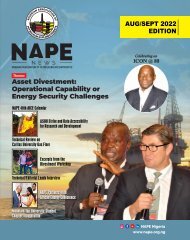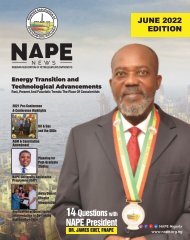NAPENews Magazine June 2023 Edition
NAPENews Magazine June 2023 Edition
NAPENews Magazine June 2023 Edition
Create successful ePaper yourself
Turn your PDF publications into a flip-book with our unique Google optimized e-Paper software.
Advanced Seismic Imaging Unlocking Potentials in Exploration<br />
and Development – Case Study Onshore Niger Delta.<br />
Omudu M.L, Amadi-Obi, N; Adesida, A; Kanu, M<br />
The Shell Petroleum Development Company of Nigeria Limited., Nigeria.<br />
Peer Reviewed Technical Article<br />
ABSTRACT<br />
The dynamics of a changing global energy outlook with attendant<br />
issues surrounding global warming, reduction of forms of<br />
greenhouse gases, and the quest for accelerated energy transition<br />
cannot be overemphasized. It becomes imperative that the oil and<br />
gas industry reduce her surface seismic acquisition footprint as<br />
much as possible where this is feasible and apply advanced seismic<br />
processing technology to harness hydrocarbon potentials in<br />
development fields and unexplored areas using existing seismic<br />
datasets.<br />
The advanced seismic processing technology deployed is Reverse<br />
Time Least Squares Migration RTLSM, while the processing<br />
applied on the legacy volume was conventional Reverse Time<br />
Migration. This paper presents results of RTLSM to address near<br />
field exploration imaging challenges in structural definition and<br />
event continuity among others using existing seismic dataset<br />
without performing any velocity update. This implies the seismic<br />
velocity used in the legacy RTM seismic is the same used in the<br />
RTLSM processing.<br />
RTLSM seismic volume showed improved imaging in faults,<br />
stratigraphic and event continuity at shallow and deep, better<br />
amplitude consistency with structure, improved signal to noise ratio<br />
and broadband width and better wavelet signature (less sidelobes).<br />
A comparative quantitative seismic diagnostic analysis carried out<br />
on the legacy RTM and the new RTLSM seismic volumes, reveals<br />
acquisition footprints and clipping in the legacy RTM volume were<br />
largely removed among other diagnostics.<br />
It is the aim of this paper to share this interesting results in deploying<br />
high end seismic processing technology to unlock hydrocarbon<br />
potentials using existing seismic data sets.<br />
Keywords: RTM, non-iterative RTLSM, Deep plays, AVA/AVO<br />
compliant gathers, Niger Delta.<br />
INTRODUCTION<br />
The field is in the swamps of the Niger Delta (Figure 1).<br />
Exploration team main challenge is with interpretation of<br />
deep plays with suboptimal resolution in faults and<br />
events continuity. Legacy RTM and PreSDM processing<br />
had been applied across the field earlier and was<br />
successfully used for the maturation of conventional<br />
amplitude-supported plays in the area. However, the<br />
RTM seismic volume is suboptimal for the<br />
imaging/maturation of the deep plays situated in the<br />
upthrown blocks behind major faults within outer shelf<br />
gross depositional environment with moderate – low<br />
internal net to gross and mud-prone channels. The prestack<br />
gathers from the PreSDM processing were also<br />
suboptimal for Quantitative Interpretation QI. The<br />
RTLSM reprocessing of the seismic data was initiated to<br />
optimize imaging (fault delineation & event continuity)<br />
and deliver QI compliant gathers for credible AvA work in<br />
support of the maturation of deep leads.<br />
Methodology<br />
Seismic migration is a technique employed in imaging of<br />
geologic interfaces in the subsurface and attempts to<br />
place recorded seismic reflection in their true spatial<br />
positions. Reverse Time Migration (RTM) and Reverse<br />
Time Least-Squares Migration (RTLSM) are both twoway<br />
wave equation migration that produce seismic<br />
Fig. 1: Location map. The study area is within the red rectangle<br />
(Source: Google Maps).<br />
wavefields of high resolution when compared with ray-based methods and one-way wave equation-based methods. High resolution<br />
seismic data is a primary driver in exploration and development of complex subsurface structures to unlock hidden potentials.<br />
RTM gives higher accuracy than other less robust/cheaper methods for imaging of steep dips. RTM uses an adjoint operator, which is not<br />
the same as the inverse, thus amplitude problems are generated which can be solved by applying a least-squares scheme in the migration.<br />
Least-squares migration (LSM) can potentially reduce migration artifacts and improve lateral resolution (Liu et al., 2019). LSM uses<br />
iterative methods to match the observed data for every iteration and can solve the amplitude inaccuracy of RTM. Therefore, RTM can be<br />
NAPENEWS JUNE <strong>2023</strong> 16










